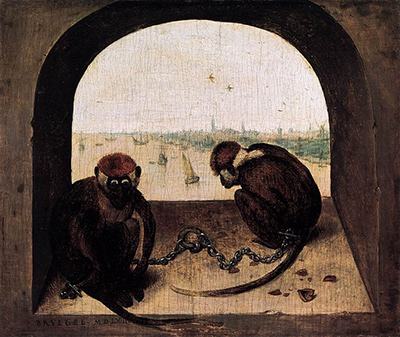Two Chained Monkeys was painted by Pieter Bruegel the Elder in 1562.
Oil on oak board, it is one of his smallest known paintings measuring 20cm x 23cm in dimension, and has been exhibited at the Gemaldegalerie, Staatliche Museen in Berlin since it was acquired in 1931.
The subject of the piece are the titular monkeys depicted sitting on a windowsill in the immediate foreground, beyond the animals through the opening is a view looking down on a busy port.
A seeming departure from the painters' tendency to populate his works with people and crowds - his other work in the Gemaldegalerie, Netherlandish Proverbs, being a good example - Two Chained Monkeys has drawn profound and varied interpretations.
A contemporary of Bruegel, the Antwerp-based cartographer and geographer Abraham Ortelius, claimed that the painters' works contain "always something beyond the painting that one has to understand".
In the absence of any information as to why the artist painted Two Monkeys the painting can be seen as an allegory, and open to many different interpretations.
It has been seen as an allegory of evil tamed, or conversely presenting man as a prisoner of sin; as a symbolic critique of the oppression of the Flemish provinces under Spanish rule; as a commentary on the misfortunes in the artists' own private life at that period; as an illustration of captivity and the hope of freedom inherent in all creatures.
All these interpretations are said by critics to have their merits when considered in the context of the political and social climate in which it was created.
In 1957, the Polish poet and future Nobel prize-winner Wislawa Szymborska published a poem entitled Brueghel's Two Monkeys, which famously references the painting and has added to the continuing fascination with the painting in modern times.




